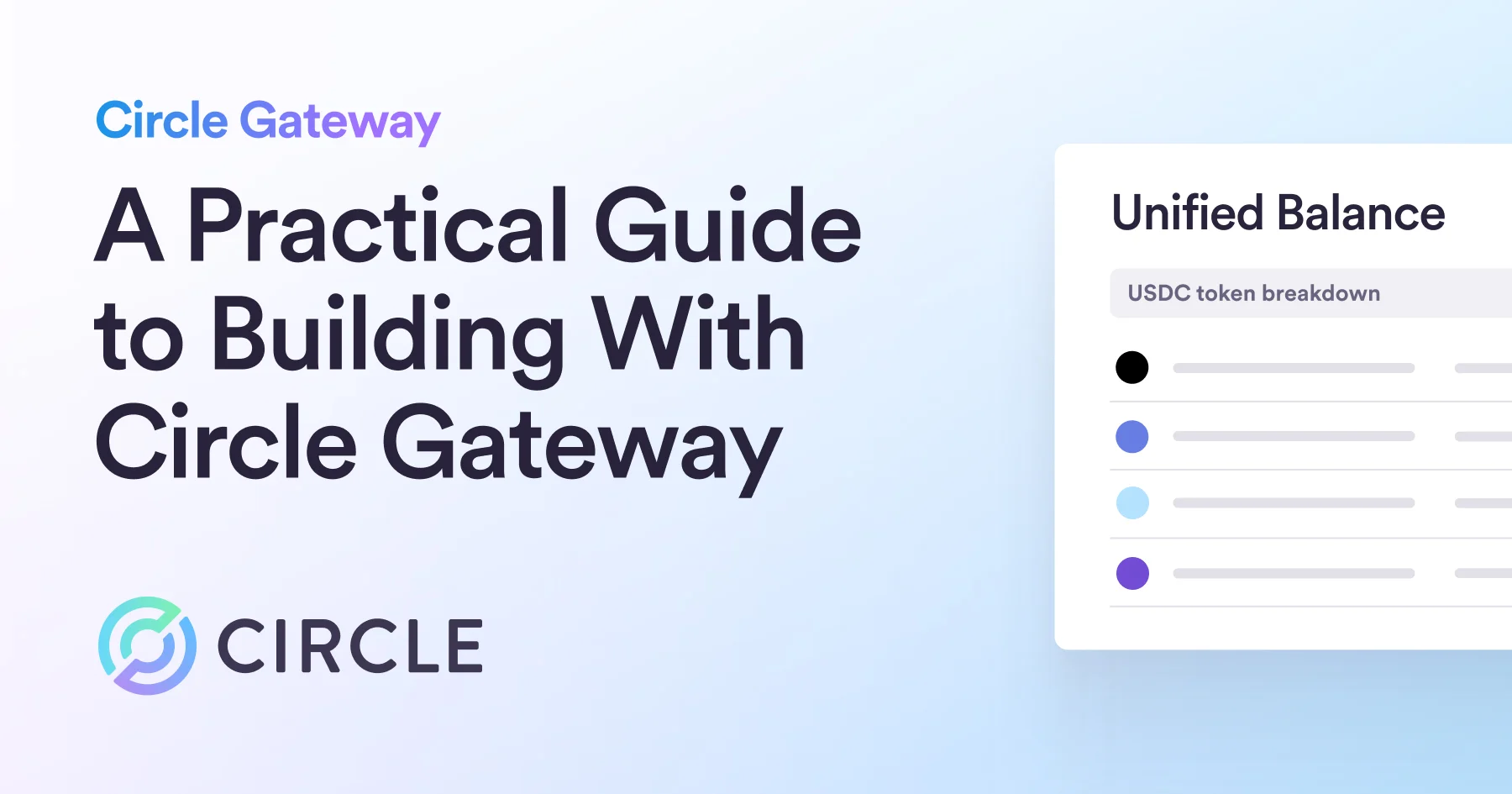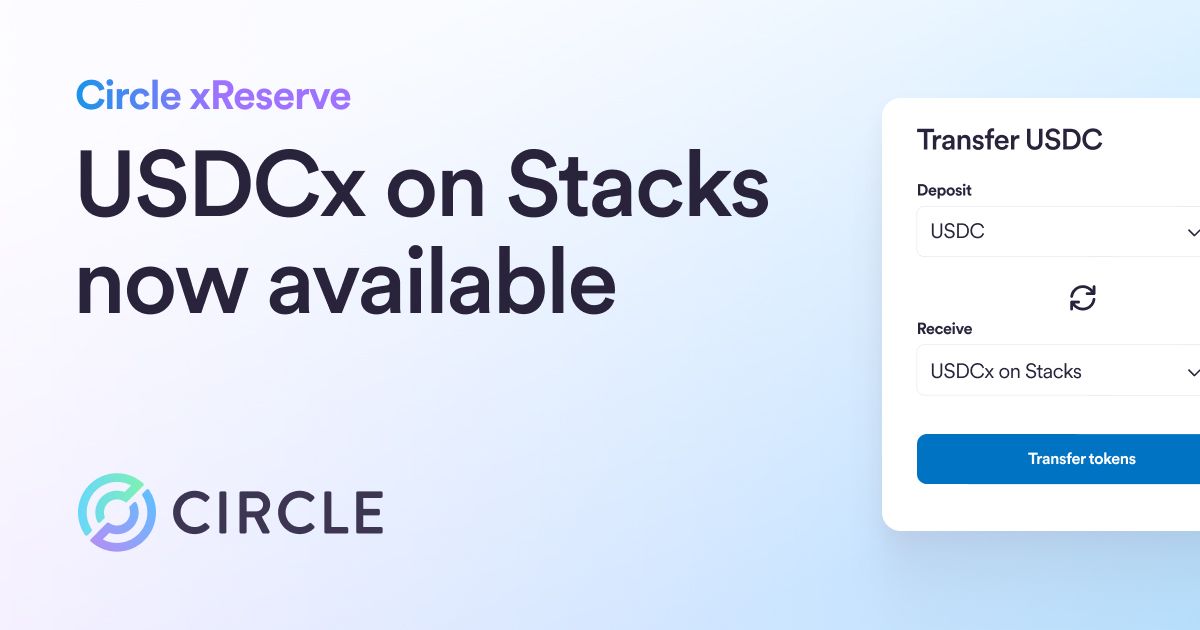Bridged USDC Standard empowers EVM blockchain and rollup teams to deploy bridged USDC with optionality for a future upgrade to native issuance. Learn more.

Deploy a bridged USDC token contract with optionality for native issuance
Permissionless composability is one of the hallmarks of Web3, contributing to the rapid growth of new applications and blockchain networks by leveraging existing open technology. Circle’s USDC is no exception, stemming from the innovations of the ERC-20 standard and countless third-party frameworks to become the trusted dollar-backed stablecoin that it is today.
As of November 2023, USDC is issued and circulating natively on 15 blockchains – 7 more than last year – and yet it is also clear to Circle and the broader community that many more blockchains may emerge and rise to prominence over the next several years. These new blockchains could benefit significantly from having access to USDC.
Native USDC vs. Bridged USDC
As we all know, native USDC provides unique advantages over bridged forms of USDC. Native issuance of USDC means that developers and users can trust that the asset they're using is fully reserved and always redeemable 1:1 for US dollars. Native USDC can be supported in Circle products like Circle Mint and Cross-Chain Transfer Protocol (CCTP), contributing to deeper ecosystem interactions and opportunities.
Interestingly, bridged forms of USDC play a key role in solving the “cold start” problem for generating activity on new blockchain networks. Unlike native USDC, bridged forms of USDC can be spun up quickly by new L1 and L2 rollup teams, in addition to third-party bridge deployers. While bridged USDC is unofficial and not issued nor redeemable by Circle, it serves as a proxy to USDC that’s extensible to any ecosystem where bridging is made possible. This helps developers bootstrap stablecoin liquidity for their applications and enables users to begin exploring new use cases early.
Ideally, Circle could bring native USDC to every secure, safe and promising new blockchain network as soon as it launches. But with the meteoric rise of scaling solutions like L2s/L3s, modular blockchains, and new high performance L1s, Circle faces a significant challenge with ecosystem innovation outpacing the speed of new USDC deployments.
As a result, Circle has often been launching native USDC on new blockchains after a large amount of USDC liquidity had already been bridged by third parties. While it’s true that developers and users can readily migrate from bridged USDC to native USDC, the ideal scenario would be to avoid a migration entirely.
So, how can Circle simultaneously enable an early path to native USDC for new blockchains, solve the cold start problem, and avoid the pitfalls of liquidity fragmentation and lengthy migrations?
This brings us back to permissionless composability and the power of community.
Introducing: Bridged USDC Standard
Bridged USDC Standard is a specification and process for deploying a bridged form of USDC on EVM blockchains with optionality for Circle to seamlessly upgrade to native issuance in the future.1
The result is a secure and standardized way for any EVM blockchain and rollup team to transfer ownership of a bridged USDC token contract to Circle to facilitate an upgrade to native USDC, if and when both parties deem appropriate.2
- Permissionless and equitable: Anyone can incorporate the standard to deploy a bridged USDC token contract, such as new L1 and L2 rollup teams, or chain-sponsored third-party bridge deployers
- Standardized and extensible: The process to securely transition ownership of a bridged USDC token contract to Circle follows a set procedure that's also extensible to bridged EURC
- Secure and audited: The standard consists of open-source ERC-20 contract code based on the same audited USDC smart contract that has secured billions of dollars in liquidity
Here's how it works:
- Third-party team follows the standard to deploy their bridged USDC token contract.
- Bridged USDC is used to bootstrap initial liquidity in the ecosystem and begins to proliferate.
- Bridged USDC reaches a significant supply, amount of holders, and number of app integrations.
- Circle and third-party team jointly elect to securely transfer ownership of the bridged USDC token contract to Circle.2
- Upon obtaining ownership, Circle upgrades bridged USDC to native USDC and seamlessly retains existing supply, holders, and app integrations.3
The benefits obtained by upgrading in-place are numerous, as the contract address, user balances, and application integrations are all maintained, ensuring a seamless experience for developers and users. Liquidity fragmentation and migration learning curves are no longer obstacles to overcome.
Benefits for all actors in the value chain
- Blockchains: Get bridged USDC into the hands of developers and users early with the potential for a seamless upgrade to native USDC in the future.
- Developers: Build on bridged USDC with a contract address that will persist after an upgrade to native USDC. No code change needed to support a new asset.
- Users: Store, pay, trade, borrow, and lend with bridged USDC that automatically becomes native USDC upon an upgrade. No need to swap to a new asset.
- Everyone: Avoid the time-consuming liquidity migration process of educating and incentivizing users to move from bridged USDC to native USDC.
Implementations are already live
We’re proud to share that the teams at Linea and Scroll have already followed the standard for their bridged USDC token contracts on their respective testnet and mainnet networks. Recently on testnet, both Linea and Scroll were able to conduct a secure transition of their respective bridged USDC token contracts to Circle’s ownership, which successfully simulates the equivalent procedure for mainnet.2
What this means for modular EVM architectures
Circle expects to expand upon the available configurations for the standard to match the specifications of the most common modular EVM architectures, such as the OP Stack. The vision for Bridged USDC Standard is to be widely incorporated into Rollup as a Service (RaaS) offerings, such that it’s easy to deploy a new blockchain with a templatized bridged USDC token contract that’s compatible with the standard by default.
The standard can also be extended to Circle’s euro-backed stablecoin by incorporating the specification when deploying a bridged EURC token contract. We’re also exploring how the standard can be re-factored for non-EVM blockchains and where commonalities exist to provide a scalable solution.
How to get started
If you’re a new EVM blockchain team or you’re a third-party bridge deployer working closely with one, dive into our implementation guide to learn how to deploy a bridged USDC token contract that follows the standard today.
Please reach out on Discord to help us assess further improvements and extensions. We welcome all feedback and innovative approaches from the community.
FAQs
Is Circle obligated to upgrade bridged USDC to native USDC?
No. Bridged USDC Standard grants Circle the option, but not the obligation, to obtain ownership of the token contract and upgrade to native USDC. In general, Circle’s decision to upgrade a particular form of bridged USDC to native USDC may be subject to additional terms and conditions.
Can an existing bridged USDC token contract be sufficiently upgraded to match the Bridged USDC Standard?
Unfortunately, no. An existing bridged USDC token contract cannot be upgraded to match the Bridged USDC Standard if the original contract deployment did not follow the standard’s technical requirements.
If I’m a third-party bridge provider, can I partner with a blockchain team to deploy a bridged USDC that follows the standard for their canonical bridge?
Yes, absolutely. Blockchain teams may benefit from the technical expertise and resources that third-party bridge providers can provide for deploying a bridged USDC token contract that follows the Bridged USDC Standard.
What’s the threshold of supply or holders that Circle is looking to see before considering upgrading a bridged USDC contract to native USDC?
There is no exact threshold of supply or holders. Circle evaluates an assortment of factors prior to considering a native deployment of USDC, or in this case, an upgrade of bridged USDC to native USDC. In general, both the size and growth rate of bridged USDC supply, holders, and apps supported will contribute significantly to how Circle prioritizes native issuance for USDC.
Is the Bridged USDC Standard appropriate for EVM appchains and parachains in the Cosmos and Polkadot ecosystems respectively?
While it’s true that the standard can be followed to deploy bridged USDC on any EVM blockchain, USDC already exists natively in the Cosmos and Polkadot ecosystems:
- USDC for the Cosmos ecosystem is natively issued on Noble and can be transferred to Cosmos appchains via Inter-Blockchain Communication (IBC).
- USDC for the Polkadot ecosystem is natively issued on Asset Hub and can be transferred to Polkadot parachains via Cross-Consensus Messaging (XCM).
As such, Circle intends for USDC to be accessed via the established protocols in each ecosystem. However, each sovereign appchain and parachain is free to choose if they prefer to deploy a bridged USDC token contract.
You mentioned Bridged USDC Standard can be extended to bridged EURC as well. What about other bridged ERC-20 token contracts?
In time, we intend to explore up-leveling the standard to provide a generalized framework for any bridged ERC-20 token contract – ideally helping to address liquidity fragmentation for the broader industry of asset issuers.
We’re also open to collaborating with the community on other approaches to help solve this shared problem, such as xERC-20 (aka ERC-7281).
I have ideas for how you could extend the Bridged USDC Standard to additional architectures. How can I contribute?
Please reach out on Discord to help us assess further improvements and extensions. We welcome all feedback and innovative approaches from the community.
1. Bridged USDC Standard grants Circle the option, but not the obligation, to obtain ownership of the token contract and upgrade to native USDC. Additionally, Bridged USDC Standard must be incorporated prior to deploying a bridged USDC token contract as it cannot be retroactively applied. The requirements provided are for informational purposes only and will apply should Circle choose to upgrade a particular form of bridged USDC to native USDC. These requirements do not constitute an offer to upgrade a particular form of bridged USDC. Circle’s decision to upgrade a particular form of bridged USDC to native USDC may be subject to additional terms and conditions. As noted in Section 8 of the USDC Terms of Use, bridged forms of USDC are subject to certain risks and are not issued by Circle.
2. The target blockchain will undergo Circle’s internal Blockchain Due Diligence Process. That process involves reviews for both compliance and risk factors, as well as coverage for legal and technology risks, prior to approval. The diligence focuses on crypto and blockchain nuances, and an assessment of the strategic, financial, operational, technology, legal, and regulatory risks that are present.
3. During the transition from bridged USDC to native USDC, Circle will securely burn the native USDC that was locked in the bridge smart contract on the origin chain (e.g. Ethereum).




